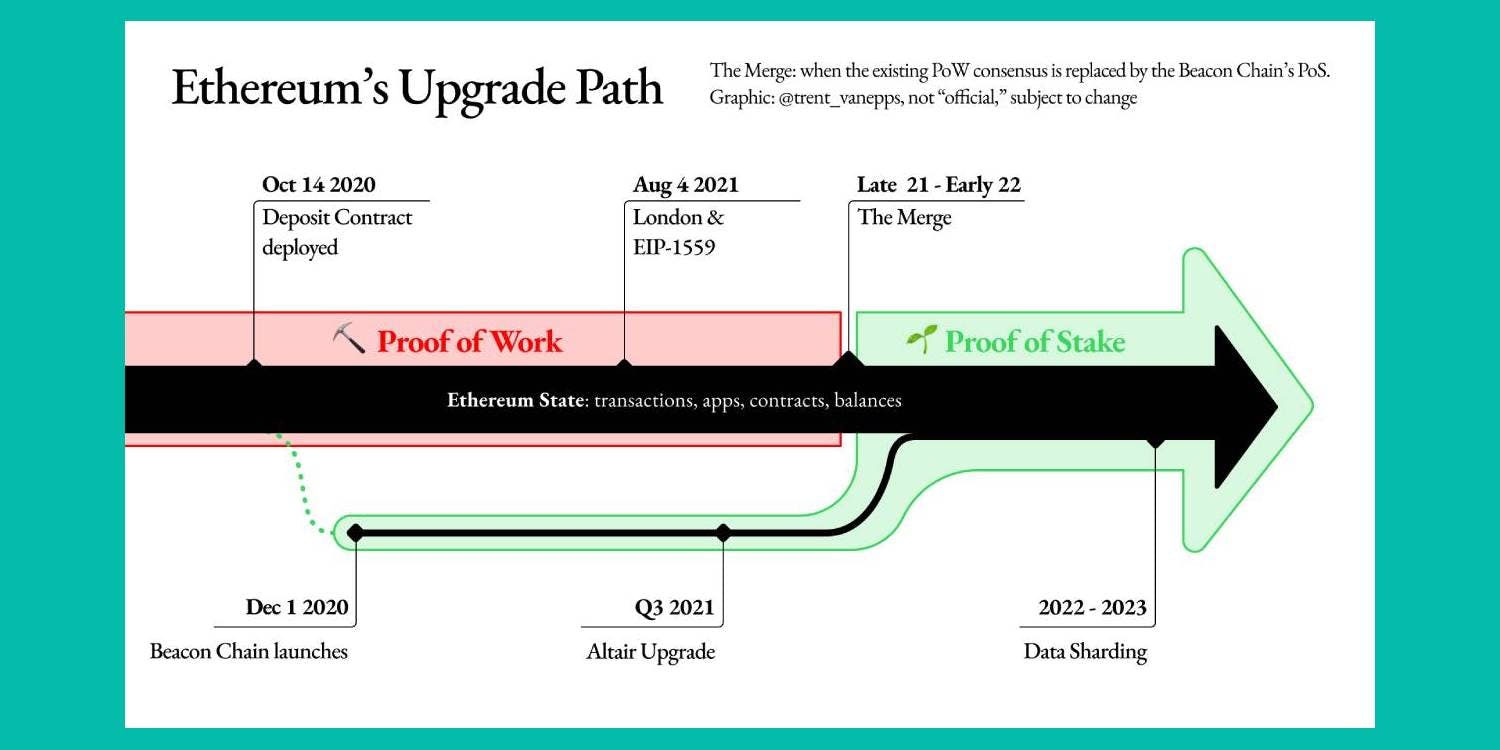Quick summary
ETH 2.0 is an upgrade of the Ethereum network that aims to make Ethereum more scalable, sustainable, and secure. It will also be the first time a major blockchain rebuilds itself with a new consensus mechanism -- shifting Ethereum from Proof of Work to Proof of Stake.
Why is ETH 2.0 needed?
Ethereum's momentum has been unstoppable since launch - DeFi, NFTs, DAOs and more. This has been despite some significant issues, like:
- Scalability: Ethereum can process an average of 14 transactions per second. This is incredibly slow and causes the network to get congested easily. When this happens, the network fee (‘gas’) becomes too expensive for most people to make a transaction. There are scaling options for Ethereum, such as Layer 2 solutions and sidechains. But, they are only part of the solution.
- Sustainability: The current consensus mechanism, Proof of Work (PoW), is energy-intensive and inefficient. This has to change.
- Security: Ethereum is secure, but this can always be improved.
ETH 2.0
ETH 2.0 is an upgrade to the Ethereum network that has been designed to solve these issues.
There are three parts to ETH 2.0: Proof of Stake, Sharding, and the Beacon Chain.
Proof of Stake (PoS)
Ethereum will shift from PoW to Proof of Stake (PoS) as its consensus mechanism. This is how blockchains agree on the transaction data. The main difference with this change is that PoW blockchains rely on miners to verify the activity on the network. And PoS depends on validators who validate transactions. Validators use their ETH as collateral for running a node, with each node requiring 32 ETH. If node operators act irresponsibly or maliciously, they lose a percentage of this stake through slashing penalties.
Sharding
Sharding is a scaling solution that splits the Ethereum blockchain into 64 smaller pieces known as ‘shards’. These shards are interconnected, running parallel to the main Ethereum network, and have a unique set of nodes processing transactions. This makes Ethereum more efficient as sharding the network reduces the computing power needed to run the blockchain. Sharding alone should improve the blockchain by at least 64x than what is currently possible.
The Beacon Chain
The Beacon Chain is the operator of ETH 2.0. It’s here where sharding and PoS get implemented. At first, the Beacon Chain is a separate blockchain that runs in parallel with the current Ethereum network until the merge. The merge is when the Beacon Chain becomes the main blockchain.
When ETH 2.0 is operational, the Beacon Chain will randomly select validators to confirm the on-chain transaction activity. This will happen every 12 seconds as one Beacon Chain block and 64 shards get added to the network. Each block will then have its activity validated by one of the randomly selected validators. Validators are chosen at random to prevent validators from coordinating or colluding together.
How will this upgrade happen?
Due to the complexity of this upgrade, ETH 2.0 will happen in stages. This graphic created by Trent Vanepps best illustrate these stages:

Phases not shown to scale - Credit: @trent_vanepps.
The Beacon Chain
The first stage of ETH 2.0 focuses on launching the Beacon Chain. Launching the Beacon Chain requires 16,384 validators, which happened on 24th November 2020, which led to the Beacon Chain launching on 1st December 2020.
The Merge
The current Ethereum blockchain merges into the Beacon Chain. This is the shift from PoW to PoS. In this phase, Layer 2 scaling solutions like rollups are expected to provide enough scaling for Ethereum.
Sharding
Sharding is the final stage of ETH 2.0 and splits the Ethereum blockchain into 64 shards. This is now happening after the Merge and will significantly improve Ethereum scaling and help rollups achieve greater transaction throughput.
Argent and ETH 2.0
Running your own validator for Ethereum 2.0 requires 32 ETH, and for many, this is inaccessible. Lido, one of our partners, solves this problem by allowing anyone to stake any amount of ETH they want. If you want to learn more about Lido, then you should read our blog post.
And if you decide to stake some of your ETH with Lido, it’s really easy to do; just follow these three steps:
- Open the Argent app
- Tap the 'invest' page and go to 'ETH2 staking'
- Tap 'Invest', select the amount you want to stake & invest

You're done. Now you're helping secure the Ethereum network. To find out about the current APY for ETH 2.0, check out staking rewards.
Further resources
The Ethereum Foundation explaining ETH 2.0
Ready to get started with DeFi?
Argent is a simple, secure, all in one wallet for investing in DeFi
Download Argent